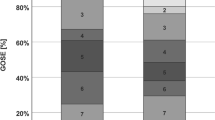Summary
Before nimodipine was introduced as a standard treatment in patients with aneurysmal subarachnoid haemorrhage (SAH) females had a significantly poorer outcome which might be due to a higher frequency of delayed cerebral ischaemia (DCI). We evaluated the overall outcome with regard to gender in 188 consecutive patients with a verified ruptured intracranial aneurysm treated with nimodipine. The only significant differences concerning prognostic factors between the sexes were a higher frequency of SAH at the primary CT in females (p<0.05) and a higher frequency of middle cerebral artery aneurysms in females (p<0.01). These factors affect the outcome in females unfavourably. However, contrary to previous studies, we found no difference in overall outcome after three months between the sexes in this clinical material. Our observation can be explained by a positive effect of nimodipine on DCI.
Similar content being viewed by others
References
Allen GS, Ahn HS, Preziosi TJ,et al (1983) Cerebral arterial vasospasm — a controlled trial of nimodipine in patients with subarachnoid hemorrhage. N Engl J Med 308: 619–624
Auer LM, Brandt L, Ebeling U,et al (1986) Nimodipine and early aneurysm operation in good condition SAH patients. Acta Neurochir (Wien) 82: 7–13
Eskesen V, Rosenørn J, Schmidt K,et al (1987) Pre-existing arterial hypertension in subarachnoid haemorrhage: an unfavourable prognostic factor. Br J Neurosurg 1: 455–461
George B, Zerah M, Mourier KL,et al (1989) Ruptured intracranial aneurysms. The influence of sex and fibromuscular dysplasia upon prognosis. Acta Neurochir (Wien) 97: 26–30
Grotenhuis JA, Bettag W, Fiebach BJO,et al (1984) Intracarotid slow bolus injection of nimodipine during angiography for treatment of cerebral vasospasm after SAH. J Neurosurg 61: 231–240
Hauerberg J, Eskesen V, Rosenørn J (1994) The prognostic significance of intracerebral haematoma as shown on CT scanning after aneurysmal subarachnoid haemorrhage. Br J Neurosurg 8: 333–339
Ljunggren B, Brandt L, Säveland H,et al (1984) Outcome in 60 consecutive patients treated with nimodipine. J Neurosurg 61: 864–873
Petruk KC, West M, Mohr G,et al (1988) Nimodipine treatment in poor-grade patients. J Neurosurg 68: 505–517
Pichard JD, Murray GD, Illingworth R,et al (1989) Effect of oral nimodipine on cerebral infarction and outcome after subarachnoid haemorrhage: British aneurysm nimodipine trial. BMJ 298: 636–642
Rosenørn J (1988) Unfavourable prognostic factors in patients with intracranial aneurysms and the possibilities to improve the overall outcome. Prog Clin Neurosci 2: 179–186
Rosenørn J, Eskesen V, Schmidt K (1987) Age as a prognostic factor after intracranial aneurysm rupture. Br J Neurosurg 1: 335–341
Rosenørn J, Eskesen V, Schmidt K (1993) Clinical features and outcome in females and males with ruptured intracranial saccular aneurysms. Br J Neurosurg 7: 287–290
Rosenørn J, Eskesen V, Schmidt K,et al (1987) Clinical features and outcome in 1076 patients with ruptured intracranial saccular aneurysms: a prospective consecutive study. Br J Neurosurg 1: 33–46
Öhman J, Heiskanen O (1988) Effect of nimodipine on the outcome of patients after aneurysmal subarachnoid hemorrhage and surgery. J Neurosurg 69: 683–686
Öhman J, Servo A, Heiskanen O (1991) Long-term effect of nimodipine on cerebral infarcts and outcome after aneurysmal subarachnoid hemorrhage and surgery. J Neurosurg 74: 8–13
Author information
Authors and Affiliations
Rights and permissions
About this article
Cite this article
Hauerberg, J., Rosenørn, J. & Skriver, E.B. Does nimodipine influence sex difference in outcome after aneurysmal subarachnoid haemorrhage?. Acta neurochir 138, 1168–1171 (1996). https://doi.org/10.1007/BF01809746
Issue Date:
DOI: https://doi.org/10.1007/BF01809746




